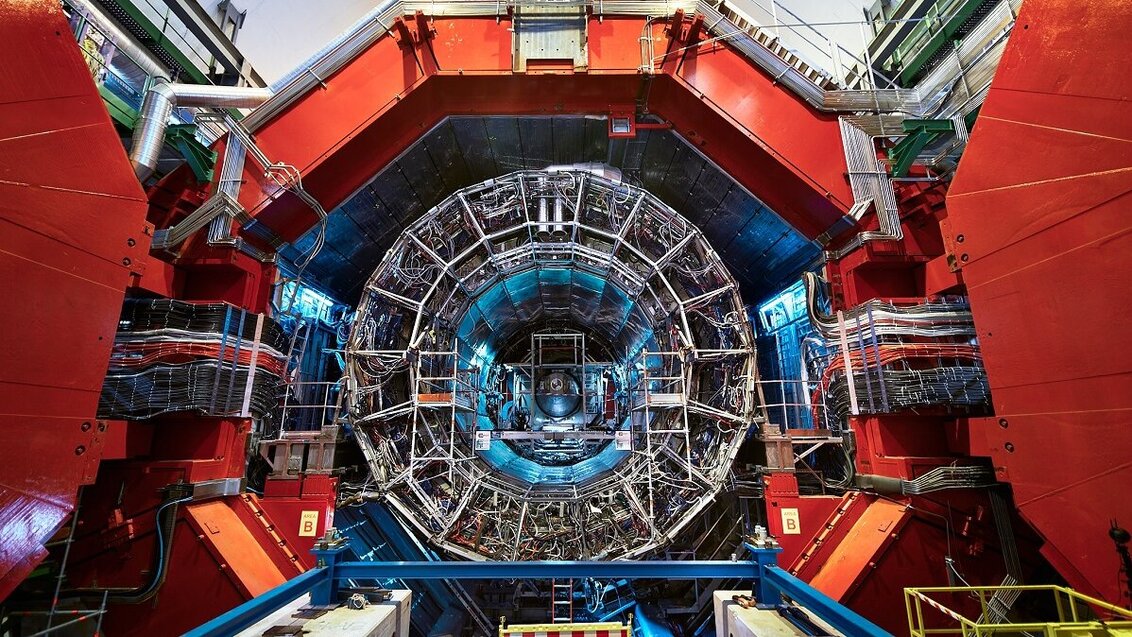For the first time, scientists have observed the dead-cone effect in high-energy proton-proton collisions, which confirms the existence of quark masses. This formidable discovery was made by physicists and engineers working on the ALICE experiment at the Large Hadron Collider (LHC).
A paper on this novelty titled “Direct observation of the dead-cone effect in quantum chromodynamics” was published in Nature. Our employees and doctoral students are co-authors of the article.
The origin of the mass of objects that make up our universe is a particularly interesting issue. Modern particle physics claims that quark masses are generated as a result of the Higgs field, manifested in the form of a recently discovered Higgs boson. These quark masses constitute only half a dozen or so of the entire nucleon mass – either a proton or a neutron. To date, quark mass measurements have been performed only by means of indirect methods. Now, however, ALICE has observed the phenomenon directly, that is, the non-zero mass of the charm quark (c).
As a result of ultra-high-energy hadron or ion collisions at the LHC, high-energy quarks are produced because of the strong force, which transfers their energy, emitting gluons. It turned out that the process of gluon emission depends on the energy of the quarks. Relatively low-energy quarks emit fewer gluons to the front – that is, a small cone opening in the direction of movement. As the energy of quarks increases so does the amount of radiation in the cone.
To observe the dead cone effect, millions of jets have been reconstructed, which were produced by charm quarks in 13 TeV proton-proton collisions, gathered by ALICE during the three-year time of the LHC’s work.
The experimental proof for the dead cone effect has a non-trivial significance. The strong force theory – quantum chromodynamics – claims that this effect can occur only with non-zero-mass quarks. The current results, published in the prestigious Nature, constitute therefore the first direct and empirical confirmation of the existence of quark masses.
The ALICE collaboration plans subsequent measurements of dead cones with heavier quarks, especially with the beauty quark (b). The updated ALICE detector will soon begin to measure proton and heavy-ion collisions at the LHC, with a frequency 10 times higher than in the years between 2015 and 2018. This will allow scientists to collect more precise data on the production of heavy quarks and their masses.
Employees from the two following AGH UST units collaborate within ALICE: the Faculty of Computer Science, Electronics, and Telecommunications and the Faculty of Electrical Engineering, Automatics, Computer Science, and Biomedical Engineering. Our university is a member of the ALICE-PL Consortium, coordinated by Professor Marek Kowalski from the Institute of Nuclear Physics of the Polish Academy of Sciences. The leader of the AGH UST team is Professor Jacek Kitowski.
(this news contains a translation of a text by Professor Jacek Otwinowski from the Institute of Nuclear Physics of the Polish Academy of Sciences in Krakow)
Co-authors from our university:
- Bartosz Baliś, Dr hab. (Faculty of Computer Science, Electronics, and Telecommunications)
- Professor Marek Gorgoń (Faculty of Electrical Engineering, Automatics, Computer Science, and Biomedical Engineering)
- Adrian Horzyk, Dr hab. (Faculty of Electrical Engineering, Automatics, Computer Science, and Biomedical Engineering)
- Mirosław Jabłoński, Dr Eng (Faculty of Electrical Engineering, Automatics, Computer Science, and Biomedical Engineering)
- Professor Jacek Kitowski (Faculty of Computer Science, Electronics, and Telecommunications)
- Piotr Konopka, MSc Eng (Faculty of Electrical Engineering, Automatics, Computer Science, and Biomedical Engineering)
- Sebastian Koryciak, MSc Eng (Faculty of Computer Science, Electronics, and Telecommunications)
- Paweł Russek, Dr hab. (Faculty of Computer Science, Electronics, and Telecommunications)

 Pre-election meeting with a candidate for the position of rector
Pre-election meeting with a candidate for the position of rector  Agreement on cooperation with OPAL-RT
Agreement on cooperation with OPAL-RT  Krakow DIANA Accelerator consortium members with an agreement
Krakow DIANA Accelerator consortium members with an agreement  Meeting with the Consul General of Germany
Meeting with the Consul General of Germany  More Academic Sports Championships finals with medals for our students
More Academic Sports Championships finals with medals for our students  Bronze for our swimmers at Academic Championships
Bronze for our swimmers at Academic Championships  Smart mountains. AGH University scholar develops an intelligent mountain rescue aid system
Smart mountains. AGH University scholar develops an intelligent mountain rescue aid system